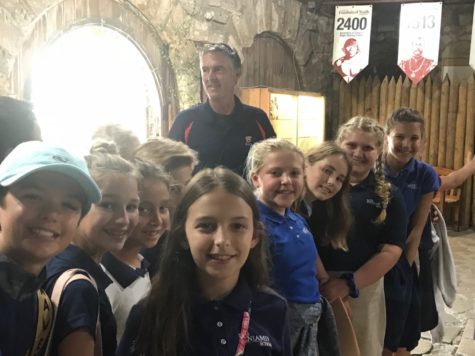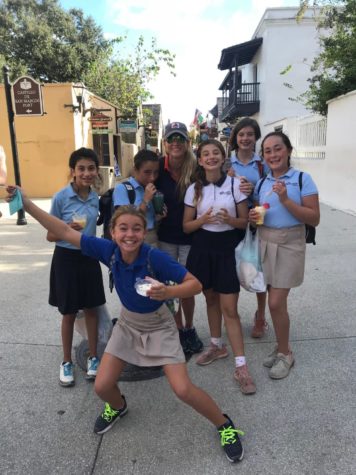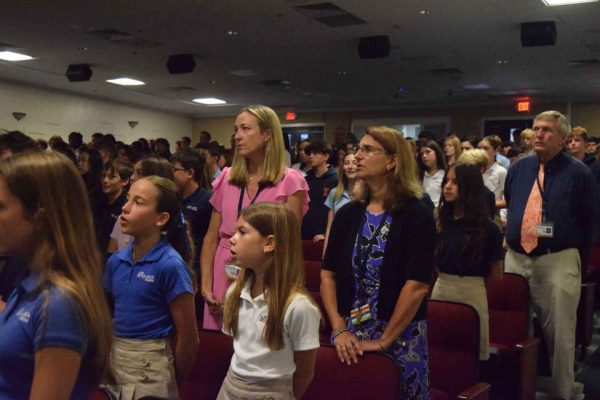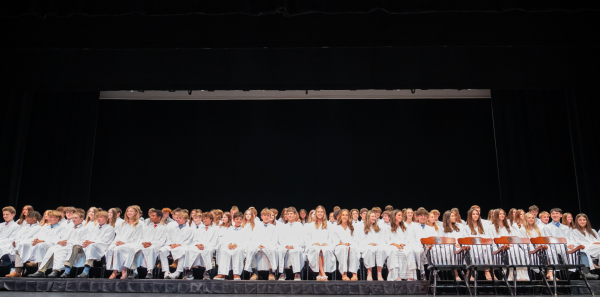Ambling Around the Ancient City
The sixth graders took a field trip to St. Augustine on October 19.
The sixth-grade boys get together for a picture outside the Castillo de San Marcos, the oldest masonry fort in the contiguous United States.
Did you know that the first Thanksgiving was held in Florida, not in Massachusetts? It took place in St. Augustine, also known as The Ancient City, on September 8, 1565. On that day, the Spanish, led by explorer Pedro Menéndez de Avilés, broke bread with the Timucua, a Native American tribe, on Florida’s coast. There was no turkey or ham that day. According to www.jaxhistory.org, which provides the history of Jacksonville and Northeast Florida, the Spanish most likely provided cocido, a rich stew made with pork, as well as garbanzo beans and onions for the feast. The Timucua might have offered wild turkey or venison, tortoise or alligator, as well as corn, beans, and squash.
Beyond being the site of the first Thanksgiving, St. Augustine is the oldest continuously occupied settlement of European origin in the United States. On October 19, the sixth-grade students went to St. Augustine for a day trip to gain some first-hand knowledge about early American life.

Mr. Oster’s group stops for a photo inside the building which houses the “Fountain of Youth.”
“The purpose of our trip was to bring history to life for our students by allowing them to see, with their own eyes, what life was like in the oldest city in America,” said sixth-grade history teacher Mrs. Chrissie Ferguson.
Many of the students had a fun time and thought that the trip was a great experience. “I thought it was cool that we got to see people using muskets and learn how the Castillo de San Marcos was built,” said sixth-grader Matthew Schepp.
The Castillo de San Marcos is a fortress overlooking the Matanzas River and was built by the Spanish in 1695. Construction started in 1672, so it took 23 years to build the fort. The fortress is so powerful and took so long to build because it is made of coquina – a rock made of shells which takes many years to dry and become hard. Coquina is similar to styrofoam. This means that it absorbs the impact of objects such as cannonballs, which only dent the walls instead of breaking them. The fortress is so strong that it was never overtaken during battle, but was ceded by treaty in 1763 when it was given to the British. Now, The Castillo de San Marcos, the oldest masonry fort in the United States, is a national monument.
The students also received a tour of The Fountain of Youth Archaeological Park in St. Augustine which houses a re-creation of The Fountain of Youth. Juan Ponce de León, the Spanish explorer that discovered Florida in 1513, was looking for the fountain, a fictitious water source that, according to legend, is supposed to make one young again if he or she drinks its water. The park claims to be the place where Ponce de León landed upon arriving in Florida, although there is no historical evidence of this. Still, the park contains a spring like the mythological one for which Ponce de León was looking. In fact, students were able to even drink some of its water which flows from an underground aquifer.

However, some students thought the water tasted terrible. “The Fountain of Youth water was so bad,” said sixth-grader Chase Bennett. “It tasted like sulfur!” The Fountain of Youth Archaeological Park also contains a number of Living History Interpreters who dress like the native Timucuans and Spanish settlers of the day and provide information about what life was like in the sixteenth and seventeenth centuries. Some of the interpreters even provided weapon demonstrations, including live firings of a crossbow, rifle, and mini cannon.
“I liked that we got to see scenic sights such as the Fountain of Youth, and a [live firing] of a cannon,” said sixth-grader Anthony Viverito.
“It’s nice to be able to visit the oldest city in America and get different perspectives of not only the colonists but the Native Americans,” added sixth-grade humanities teacher Mrs. Denise Ponchock.
The trip also helped students comprehend their current unit of study in history class. “[The trip] helped us with our chapter, which is about European expeditions to America,” said Schepp.
“We’re learning about the colonization of America, and [our history teachers] wanted us to see it first-hand,” remarked Viverito.
For the teachers, it was an opportunity to have their students get a hands-on feel for early America.“The great part about the St. Augustine trip is it’s a connection to history within driving distance,” said Ponchock, “so we got to visit the Fort and many places that students had been studying, plus it really brings to life Colonial America. We’re able to talk about the Spanish colonization when normally we study mostly the British colonies.”
While the teachers and students enjoyed the special trip, many of the teachers’ favorite aspect was seeing their students react to all that they saw. “This trip to St. Augustine was particularly special to me because I had the opportunity to witness the excitement in the faces of my students as they made connections to the history lessons we discussed in class,” said Ferguson.





